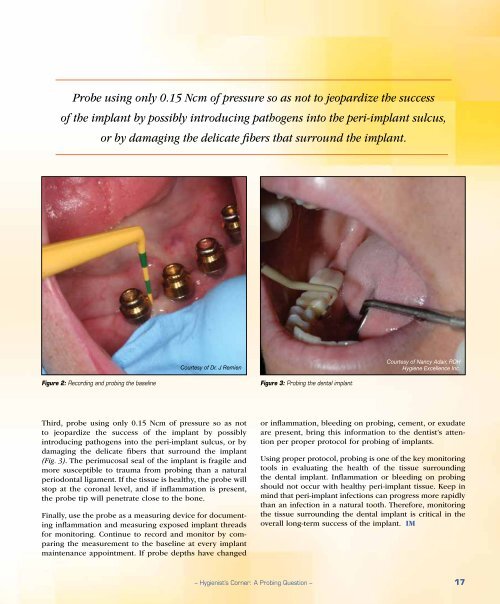PDF Download - Glidewell Dental Labs
PDF Download - Glidewell Dental Labs
PDF Download - Glidewell Dental Labs
Create successful ePaper yourself
Turn your PDF publications into a flip-book with our unique Google optimized e-Paper software.
Probe using only 0.15 Ncm of pressure so as not to jeopardize the success<br />
of the implant by possibly introducing pathogens into the peri-implant sulcus,<br />
or by damaging the delicate fibers that surround the implant.<br />
Courtesy of Dr. J Remien<br />
Courtesy of Nancy Adair, RDH<br />
Hygiene Excellence Inc.<br />
Figure 2: Recording and probing the baseline<br />
Figure 3: Probing the dental implant<br />
Third, probe using only 0.15 Ncm of pressure so as not<br />
to jeopardize the success of the implant by possibly<br />
introducing pathogens into the peri-implant sulcus, or by<br />
damaging the delicate fibers that surround the implant<br />
(Fig. 3). The perimucosal seal of the implant is fragile and<br />
more susceptible to trauma from probing than a natural<br />
periodontal ligament. If the tissue is healthy, the probe will<br />
stop at the coronal level, and if inflammation is present,<br />
the probe tip will penetrate close to the bone.<br />
Finally, use the probe as a measuring device for documenting<br />
inflammation and measuring exposed implant threads<br />
for monitoring. Continue to record and monitor by comparing<br />
the measurement to the baseline at every implant<br />
maintenance appointment. If probe depths have changed<br />
or inflammation, bleeding on probing, cement, or exudate<br />
are present, bring this information to the dentist’s attention<br />
per proper protocol for probing of implants.<br />
Using proper protocol, probing is one of the key monitoring<br />
tools in evaluating the health of the tissue surrounding<br />
the dental implant. Inflammation or bleeding on probing<br />
should not occur with healthy peri-implant tissue. Keep in<br />
mind that peri-implant infections can progress more rapidly<br />
than an infection in a natural tooth. Therefore, monitoring<br />
the tissue surrounding the dental implant is critical in the<br />
overall long-term success of the implant. IM<br />
– Hygienist’s Corner: A Probing Question – 17

















